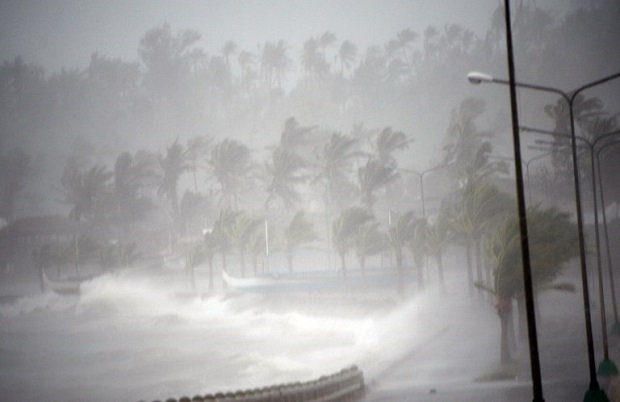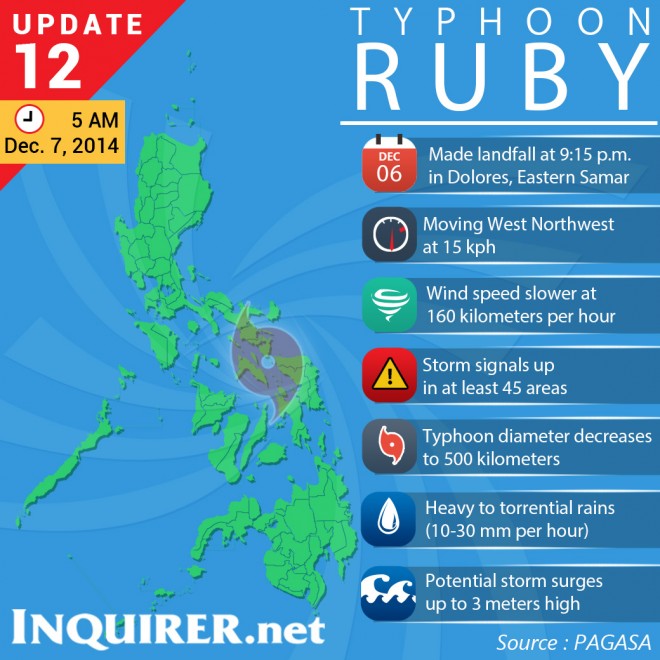Ruby tears down homes in disaster-weary Philippines

Strong winds and rain pound the seawall hours before Typhoon Hagupit passes near the city of Legazpi on December 7, 2014. Typhoon Hagupit tore apart homes and sent waves crashing through coastal communities across the eastern Philippines, creating more misery for millions following a barrage of deadly disasters. AFP/TED ALJIBE
LEGAZPI CITY, Philippines–Typhoon Ruby (Hagupit) tore apart homes and sent waves crashing through coastal communities across the eastern Philippines on Sunday, creating more misery for millions following a barrage of deadly disasters.
The typhoon roared in from the Pacific Ocean and crashed into remote fishing communities of Samar island on Saturday night with wind gusts of 210 kilometers an hour, local weather agency Pagasa said.
The wind strength made Ruby the most powerful storm to hit the Philippines this year, exceeding a typhoon in July that killed more than 100 people.
“Tin roofs are flying off, trees are falling and there is some flooding,” Stephany Uy-Tan, the mayor of Catbalogan, a major city on Samar, told AFP by phone minutes after Ruby made landfall.
Fearful of a repeat of last year when Super Typhoon Yolanda (Haiyan) claimed more than 7,350 lives, the government undertook a massive evacuation effort ahead of Ruby that saw millions of people seek shelter.
Ruby was forecast to take three days to cut across the Philippines, passing over mostly poor central regions, while also bringing heavy rain to the densely populated capital of Manila slightly to the north.
The government warned of storm surges up to 16-feet high in some areas, flash flooding, landslides and winds strong enough to tear apart even sturdy homes.
Tens of millions of people live in the typhoon’s path, including those in the central Philippines who are still struggling to recover from the devastation of Haiyan, which hit 13 months ago.
Yolanda was the strongest storm ever recorded on land, with winds of 315 kilometers an hour, and generated tsunami-like storm surges that laid to waste entire towns.
As day broke on Sunday, many areas across the eastern Philippines could not be reached by phone and it was impossible to know how badly they were damaged, Red Cross secretary general Gwendolyn Pang told AFP.
In those that were reachable, residents and officials reported terrifying winds and waves that destroyed homes, although with most people in evacuation centers there were hopes casualties would be few.
In Tacloban, one of the cities worst-hit by Yolanda, palm-thatch temporary houses built by aid agencies for survivors of last year’s typhoon had been torn apart, Vice Mayor Jerry Yaokasin told AFP.
‘Better prepared’
However there was no repeat of the storm surges that did the most damage during Yolanda.
“There is a collective sigh of relief. The initial assessment is that there are no casualties. We were better prepared after Yolanda, up to 50,000 people were packed in evacuation centers,” he said.
“But the transitional shelters made of nipa (palm thatch) were blown away. Our biggest challenge is how to provide for those who were displaced because of that.”
In the eastern region of Bicol that is due to be hit throughout Sunday and Monday, authorities said they were aiming for 2.5 million people — half the local population — to be in evacuation centers.
At dawn on Sunday, huge waves pounded the coast of Legaspi, a major city in Bicol that was due to feel Ruby’s full force later in the day.
Walls of walls of seawater more than one-metre high crashed above the city’s seawall and sprayed water and debris onto the deserted Legaspi Boulevard, according to an AFP reporter.
The Philippines endures about 20 major storms a year which, along with regular earthquakes and volcano eruptions, make it one of the world’s most disaster-plagued countries.
The storms regularly claim many lives but they are becoming more violent and unpredictable because of climate change, according to the United Nations and many scientists.
Haiyan was the world’s deadliest natural disaster last year.
In 2011 and 2012, there were consecutive December storms that together claimed more than 3,000 lives and were the word’s deadliest disasters of those years.
And in July this year, Typhoon Glenda (Rammasun) killed 111 people when it cut across Manila, paralyzing the capital for days, and other parts of the main island of Luzon.
RELATED STORIES
2,500 sea travelers stranded, says Coast Guard
Over 500,000 in evacuation centers–Soliman
4 airports shut down due to Ruby















